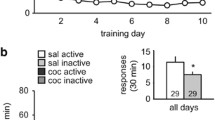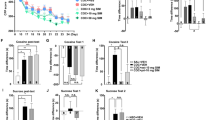Abstract
Rationale
Environmental stimuli, or cues, associated with the use of drugs such as cocaine are one of the primary drivers of relapse. Thus, identifying mechanisms to reduce the motivational properties of drug cues is an important research goal.
Objectives
The purpose of this study was to identify cellular signaling events in the nucleus accumbens (NAc) that are induced when a cocaine cue memory is either extinguished through repeated cue presentation in the absence of drug, or when the memory is reactivated and reconsolidated by a brief cue re-exposure. Signaling events specific to extinction or reconsolidation represent potential targets for pharmacotherapeutics that may enhance extinction or disrupt reconsolidation to reduce the likelihood of relapse.
Methods
Male Sprague-Dawley rats were trained to self-administer cocaine paired with an audiovisual cue. Following a period of self-administration, the memory for the cocaine-associated cue was either extinguished, reactivated, or not manipulated (control) 15 min before sacrifice. Tissue from the NAc was subsequently analyzed using mass spectrometry based phosphoproteomics to identify cellular signaling events induced by each condition.
Results
Extinction and reconsolidation of the cocaine cue memory produced both common and distinct changes in protein phosphorylation. Notably, there were no significant changes in protein phosphorylation that were modulated in the opposite direction by the two behavioral conditions. Comparison of NAc phosphoproteomic changes to previously identified changes in the basolateral amygdala (BLA) revealed that cue extinction increases phosphorylation at serine (S) 883 of the GABAB receptor subunit 2 and on S14 of syntaxin 1a in both regions, while no common regional signaling events were identified in the reconsolidation group.
Conclusions
Phosphoproteomics is a useful tool for identifying signaling cascades involved in different memory processes and revealed novel potential targets for selectively targeting extinction versus reconsolidation of a cocaine cue memory. Furthermore, cross region analysis suggests that cue extinction may produce unique signaling events associated with increased inhibitory signaling.




Similar content being viewed by others
References
Benjamini Y, Hochberg Y (1995) Controlling the false discovery rate: a practical and powerful approach to multiple testing. J R Stat Soc Ser B 57:289–300
Bouton ME, Winterbauer NE, Todd TP (2012) Relapse processes after the extinction of instrumental learning: renewal, resurgence, and reacquisition. Behav Process 90:130–141. https://doi.org/10.1016/j.beproc.2012.03.004
Childress AR, Mozley PD, McElgin W, Fitzgerald J, Reivich M, O’Brien CP (1999) Limbic activation during cue-induced cocaine craving. Am J Psychiatry 156:11–18
Conklin CA, Tiffany ST (2002) Applying extinction research and theory to cue-exposure addiction treatments. Addiction 97:155–167
Couve A, Thomas P, Calver AR, Hirst WD, Pangalos MN, Walsh FS, Smart TG, Moss SJ (2002) Cyclic AMP-dependent protein kinase phosphorylation facilitates GABA(B) receptor-effector coupling. Nat Neurosci 5:415–424. https://doi.org/10.1038/nn833
Eisenberg M, Dudai Y (2004) Reconsolidation of fresh, remote, and extinguished fear memory in medaka: old fears don’t die. Eur J Neurosci 20:3397–3403. https://doi.org/10.1111/j.1460-9568.2004.03818.x
Fox HC, Bergquist KL, Hong K-I, Sinha R (2007) Stress-induced and alcohol cue-induced craving in recently abstinent alcohol-dependent individuals. Alcohol Clin Exp Res 31:395–403. https://doi.org/10.1111/j.1530-0277.2006.00320.x
Fuchs RA, Evans KA, Parker MC, See RE (2004) Differential involvement of the core and shell subregions of the nucleus accumbens in conditioned cue-induced reinstatement of cocaine seeking in rats. Psychopharmacology 176:459–465. https://doi.org/10.1007/s00213-004-1895-6
Fuchs RA, Feltenstein MW, See RE (2006) The role of the basolateral amygdala in stimulus-reward memory and extinction memory consolidation and in subsequent conditioned cued reinstatement of cocaine seeking. Eur J Neurosci 23:2809–2813. https://doi.org/10.1111/j.1460-9568.2006.04806.x
Fuchs RA, Bell GH, Ramirez DR, Eaddy JL, Su ZI (2009) Basolateral amygdala involvement in memory reconsolidation processes that facilitate drug context-induced cocaine seeking. Eur J Neurosci 30:889–900. https://doi.org/10.1111/j.1460-9568.2009.06888.x
Garavan H, Pankiewicz J, Bloom A, Cho JK, Sperry L, Ross TJ, Salmeron BJ, Risinger R, Kelley D, Stein EA (2000) Cue-induced cocaine craving: neuroanatomical specificity for drug users and drug stimuli. Am J Psychiatry 157:1789–1798
Gil C, Falqués A, Sarró E, Cubí R, Blasi J, Aguilera J, Itarte E (2011) Protein kinase CK2 associates to lipid rafts and its pharmacological inhibition enhances neurotransmitter release. FEBS Lett 585:414–420. https://doi.org/10.1016/j.febslet.2010.12.029
Hellemans KGC, Everitt BJ, Lee JLC (2006) Disrupting reconsolidation of conditioned withdrawal memories in the basolateral amygdala reduces suppression of heroin seeking in rats. J Neurosci 26:12694–12699. https://doi.org/10.1523/JNEUROSCI.3101-06.2006
Hirosawa M, Hoshida M, Ishikawa M, Toya T (1993) MASCOT: multiple alignment system for protein sequences based on three-way dynamic programming. Comput Appl Biosci 9:161–167
Huttlin EL, Jedrychowski MP, Elias JE, Goswami T, Rad R, Beausoleil SA, Villén J, Haas W, Sowa ME, Gygi SP (2010) A tissue-specific atlas of mouse protein phosphorylation and expression. Cell 143:1174–1189. https://doi.org/10.1016/j.cell.2010.12.001
Lee JLC, Di Ciano P, Thomas KL, Everitt BJ (2005) Disrupting reconsolidation of drug memories reduces cocaine-seeking behavior. Neuron 47:795–801. https://doi.org/10.1016/j.neuron.2005.08.007
Lee JLC, Milton AL, Everitt BJ (2006) Reconsolidation and extinction of conditioned fear: inhibition and potentiation. J Neurosci 26:10051–10056. https://doi.org/10.1523/JNEUROSCI.2466-06.2006
Maren S (2014) Out with the old and in with the new: synaptic mechanisms of extinction in the amygdala. Brain Res 1621:231–238. https://doi.org/10.1016/j.brainres.2014.10.010
Merlo E, Milton AL, Goozee ZY, Theobald DE, Everitt BJ (2014a) Reconsolidation and extinction are dissociable and mutually exclusive processes: behavioral and molecular evidence. J Neurosci 34:2422–2431. https://doi.org/10.1523/JNEUROSCI.4001-13.2014
Merlo E, Milton AL, Goozée ZY et al (2014b) Reconsolidation and extinction are dissociable and mutually exclusive processes: behavioral and molecular evidence. J Neurosci 34:2422–2431. https://doi.org/10.1523/JNEUROSCI.4001-13.2014
Miller CA, Marshall JF (2005) Molecular substrates for retrieval and reconsolidation of cocaine-associated contextual memory. Neuron 47:873–884. https://doi.org/10.1016/j.neuron.2005.08.006
Nørskov-Lauritsen L, Bräuner-Osborne H (2015) Role of post-translational modifications on structure, function and pharmacology of class C G protein-coupled receptors. Eur J Pharmacol 763:233–240. https://doi.org/10.1016/j.ejphar.2015.05.015
O’Brien CP, Childress AR, McLellan T, Ehrman R (1990) Integrating systemic cue exposure with standard treatment in recovering drug dependent patients. Addict Behav 15:355–365
O’Brien CP, Childress AR, McLellan AT, Ehrman R (1993) Developing treatments that address classical conditioning. NIDA Res Monogr 135:71–91
Orsini CA, Maren S (2012) Neural and cellular mechanisms of fear and extinction memory formation. Neurosci Biobehav Rev 36:1773–1802. https://doi.org/10.1016/j.neubiorev.2011.12.014
Price KL, Baker NL, McRae-Clark AL et al (2013) A randomized, placebo-controlled laboratory study of the effects of d-cycloserine on craving in cocaine-dependent individuals. Psychopharmacology 226:739–746. https://doi.org/10.1007/s00213-011-2592-x
Rich MT, Abbott TB, Chung L, Gulcicek EE, Stone KL, Colangelo CM, Lam TT, Nairn AC, Taylor JR, Torregrossa MM (2016) Phosphoproteomic analysis reveals a novel mechanism of CaMKIIα regulation inversely induced by cocaine memory extinction versus reconsolidation. J Neurosci 36:7613–7627. https://doi.org/10.1523/JNEUROSCI.1108-16.2016
Rich MT, Huang YH, Torregrossa MM (2018) Plasticity at thalamo-amygdala synapses regulates cocaine-cue memory formation and extinction. SSRN Electron J. https://doi.org/10.2139/ssrn.3205405
Rizo J (2018) Mechanism of neurotransmitter release coming into focus. Protein Sci 27:1364–1391. https://doi.org/10.1002/pro.3445
Sanchez H, Quinn JJ, Torregrossa MM, Taylor JR (2010) Reconsolidation of a cocaine-associated stimulus requires amygdalar protein kinase A. J Neurosci 30:4401–4407. https://doi.org/10.1523/JNEUROSCI.3149-09.2010
Sinha R, Li CSR (2007) Imaging stress- and cue-induced drug and alcohol craving: association with relapse and clinical implications. Drug Alcohol Rev 26:25–31
Taylor JR, Olausson P, Quinn JJ, Torregrossa MM (2009) Targeting extinction and reconsolidation mechanisms to combat the impact of drug cues on addiction. Neuropharmacology 56(Suppl 1):186–195. https://doi.org/10.1016/j.neuropharm.2008.07.027
Théberge FRM, Milton AL, Belin D et al (2010) The basolateral amygdala and nucleus accumbens core mediate dissociable aspects of drug memory reconsolidation. Learn Mem 17:444–453. https://doi.org/10.1101/lm.1757410
Torregrossa MM, Kalivas PW (2008) Neurotensin in the ventral pallidum increases extracellular gamma-aminobutyric acid and differentially affects cue- and cocaine-primed reinstatement. J Pharmacol Exp Ther 325:556–566. https://doi.org/10.1124/jpet.107.130310
Torregrossa MMM, Taylor JRJR (2012) Learning to forget: manipulating extinction and reconsolidation processes to treat addiction. Psychopharmacology 226:659–672. https://doi.org/10.1007/s00213-012-2750-9
Torregrossa MMM, Sanchez H, Taylor JRR (2010) D-cycloserine reduces the context specificity of pavlovian extinction of cocaine cues through actions in the nucleus accumbens. J Neurosci 30:10526–10533. https://doi.org/10.1523/JNEUROSCI.2523-10.2010
Torregrossa MMM, Gordon J, Taylor JRR (2013) Double dissociation between the anterior cingulate cortex and nucleus accumbens core in encoding the context versus the content of pavlovian cocaine cue extinction. J Neurosci 33:8370–8377. https://doi.org/10.1523/JNEUROSCI.0489-13.2013
Tronson NC, Taylor JR (2007) Molecular mechanisms of memory reconsolidation. Nat Rev Neurosci 8:262–275. https://doi.org/10.1038/nrn2090
Wan X, Torregrossa MMM, Sanchez H et al (2014) Activation of exchange protein activated by cAMP in the rat basolateral amygdala impairs reconsolidation of a memory associated with self-administered cocaine. PLoS One 9:e107359. https://doi.org/10.1371/journal.pone.0107359
Wells AM, Arguello AA, Xie X, Blanton MA, Lasseter HC, Reittinger AM, Fuchs RA (2013) Extracellular signal-regulated kinase in the basolateral amygdala, but not the nucleus accumbens core, is critical for context-response-cocaine memory reconsolidation in rats. Neuropsychopharmacology 38:753–762. https://doi.org/10.1038/npp.2012.238
Funding
This work received financial support from USPHS grants DA042029 (M.M.T.), K01DA031745 (M.M.T.), DA018343 (A.C.N., T.T.L.), and DA015222 (J.R.T.).
Author information
Authors and Affiliations
Corresponding author
Ethics declarations
Conflicts of interest
The authors declare that there is no conflict of interest.
Additional information
This article belongs to a Special Issue on Psychopharmacology of Extinction
Rights and permissions
About this article
Cite this article
Torregrossa, M.M., MacDonald, M., Stone, K.L. et al. Phosphoproteomic analysis of cocaine memory extinction and reconsolidation in the nucleus accumbens. Psychopharmacology 236, 531–543 (2019). https://doi.org/10.1007/s00213-018-5071-9
Received:
Accepted:
Published:
Issue Date:
DOI: https://doi.org/10.1007/s00213-018-5071-9




